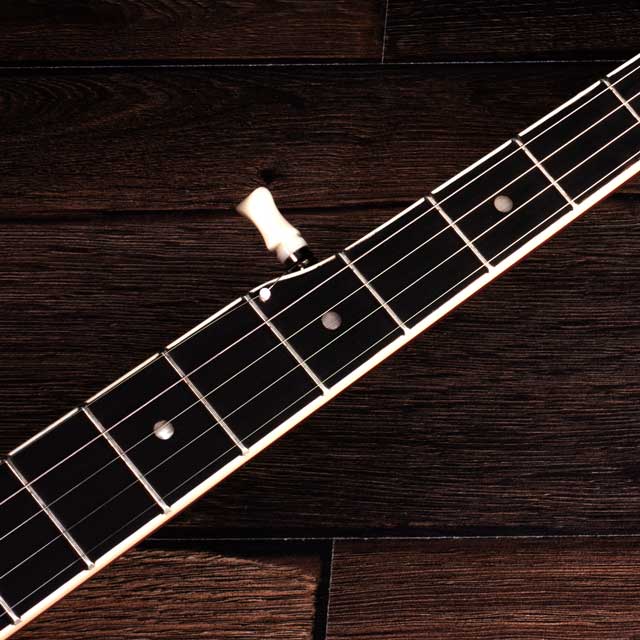
Banjo FAQs
What type of banjo should I buy?
 You can be forgiven for being confused by the number of different types of banjo available. 5-string banjos are the most widely played, but there’s much more to discover with 4-string, ‘Irish / Gaelic’, 6-string, and even banjo-ukuleles!
You can be forgiven for being confused by the number of different types of banjo available. 5-string banjos are the most widely played, but there’s much more to discover with 4-string, ‘Irish / Gaelic’, 6-string, and even banjo-ukuleles!
Then there’s the question of ‘open-back’ and ‘resonator’ banjos… what’s the difference?
Don’t worry… Here’s our Barnes & Mullins guide to all types of banjos and their playing styles.
How should I tune my banjo?
 There are many ways to tune your banjo to achieve new sounds and playing styles. Although each type of banjo has its generally accepted standard tuning, unlike many other stringed instruments, there are no hard and fast rules to abide to. The banjo offers a variety of alternate tunings which further enhance your exploration of the instrument.
There are many ways to tune your banjo to achieve new sounds and playing styles. Although each type of banjo has its generally accepted standard tuning, unlike many other stringed instruments, there are no hard and fast rules to abide to. The banjo offers a variety of alternate tunings which further enhance your exploration of the instrument.
Take a look at our run-through of all common banjo tunings HERE.
Is it easy to learn the banjo?
 If you’re reading this, it’s more than likely you already play the banjo or have an interest in learning. If it’s the latter, then the banjo really is a great choice! It is a relatively comfortable instrument to hold and isn’t overly taxing on your fingers like some guitars and bowed instruments can be.
If you’re reading this, it’s more than likely you already play the banjo or have an interest in learning. If it’s the latter, then the banjo really is a great choice! It is a relatively comfortable instrument to hold and isn’t overly taxing on your fingers like some guitars and bowed instruments can be.
The many types and tunings of the banjo mean it’s an instrument that naturally inspires and rewards exploration. Familiarise yourself with the rich history of the different types of banjo music from bluegrass to traditional jazz, Irish to country music, see what piques your interest and go from there.
5-String banjos are an excellent choice for beginners as most popular bluegrass and old time music is played on them. They are commonly tuned to open G – G, D, G, B, D – meaning a G chord is produced when removing all fingers from the fingerboard and then strumming. This tuning is great for exploring the instrument and learning the fundamental scales and chords that will see you well on your way to mastering the banjo in no time at all.
For guitarists looking to transition into playing the banjo, 6-string banjos are tuned exactly the same as a guitar so you can easily transfer your existing understanding, skill set and licks to the banjo.
Barnes & Mullins have been manufacturing high-quality banjos since 1895 and therefore have extensive knowledge and experience in producing instruments designed specifically to make learning the banjo as easy and enjoyable as possible.
What are all the parts of a banjo called?
 It’s safe to say that there are a lot of components that make up a banjo. Of course, that means there’s also a comprehensive lingo too. Not sure what the ‘coordinator rod’ is, or confused which part the ‘heel’ is?
It’s safe to say that there are a lot of components that make up a banjo. Of course, that means there’s also a comprehensive lingo too. Not sure what the ‘coordinator rod’ is, or confused which part the ‘heel’ is?
Take a look at our Anatomy of a Banjo page HERE
Why doesn’t my banjo sound very good?

- As with all stringed instruments, it is important to make sure your banjo is properly tuned. Just one string ever so slightly out of tune can make your chords sound noticeably nasty. It’s always best to tune your banjo with an electric tuner before playing. Find out more about banjo tunings HERE.
- Staying with strings for a second, it is important to change your banjo strings regularly. Old and worn strings will have a detrimental effect on the way your banjo sounds by deadening its overall tone and volume. Dirty and oxidised strings also won’t allow your fingers to glide over them easily, so your banjo will also feel bad to play. We generally recommend changing your strings around every two months if you’re someone who spends an average amount of time practicing.
- Make sure your strings are seated correctly at both the bridge and nut of your banjo. This is a common cause of string buzz.
- Tighten your banjo head correctly. You can read more about this in our ‘What is head tension’ section.
- Keep an eye on your bridge. Although it takes a long time, bridges can wear and drop over time. This vital component plays a key role in delivering individual string articulation and an overall balanced tone and can be a pesky culprit if your banjo starts to sound bad.
- Check your intonation. Without getting into the extensive specifics of what exactly intonation is (we could be here a long time!), poor intonation is a common cause of why your banjo can suddenly not sound great. Essentially, intonation refers to the relationship between the position of the bridge in relation to the overall length of the string (scale length). If your bridge isn’t positioned incorrectly – and remember, banjo bridges aren’t fixed to the body like guitars, so they can easily move – it can cause chords to sound odd despite the banjo being in tune. A good way to test whether your intonation is correct is to play chord shapes higher up the neck. If they don’t sound as they should, this is an indicator that your intonation is out, and that your banjo isn’t ‘in tune with itself’. You’ll need to make some small adjustments to the position of your bridge until you hit the sweet spot.
Remember! To ensure your banjo reaches you in its optimal playing condition, each instrument is inspected and set up by our expert technical team in the United Kingdom before making its way to our retail partners.
How high should the strings be above the frets?
 The normal string height – or ‘action’ - on banjos should be set at 1/8” above the 12th fret. Remember that each instrument is unique and may require some minor bespoke tweaks to these generally accepted measurements, but as a rule of thumb, your action should be low enough so that playing is easy and you’re not having to press the strings down too hard, but not so low that your strings buzz against the frets when played.
The normal string height – or ‘action’ - on banjos should be set at 1/8” above the 12th fret. Remember that each instrument is unique and may require some minor bespoke tweaks to these generally accepted measurements, but as a rule of thumb, your action should be low enough so that playing is easy and you’re not having to press the strings down too hard, but not so low that your strings buzz against the frets when played.
Remember! To ensure your banjo reaches you in its optimal playing condition, each instrument is inspected and set up by our expert technical team in the United Kingdom before making its way to our retail partners.
What are coordinator rods?
 You’ve likely heard about coordinator rods (also called rim rods) but might be unsure as to what they are and exactly what their purpose is. Coordinator rods run from the base of the rim – the circular wooden piece that makes up your banjo’s body (also called ‘pot’) – through the centre and into the banjo neck.
You’ve likely heard about coordinator rods (also called rim rods) but might be unsure as to what they are and exactly what their purpose is. Coordinator rods run from the base of the rim – the circular wooden piece that makes up your banjo’s body (also called ‘pot’) – through the centre and into the banjo neck.
Their primary purpose is to connect the neck of your banjo to the body, but they can also be adjusted to alter the neck angle of your banjo to change its action and the way it feels to play.
Coordinator rods aren’t visible on resonator banjos as they’re hidden by the resonator – you’ll have to remove the resonator to get to them. They are visible and more easily accessable on open back banjos.
Some banjos feature one coordinator rod, others feature two. Although it does add a little more weight to banjos, a second coordinator rod enhances the stability of the body of the banjo. It’s common for bulkier and weightier resonator banjos to feature two coordinator rods. Where two rods are used, only one is used for neck adjustment – the second simply acts as an additional support mechanism.
To ensure the highest level of playing and tonal stability, the majority of Barnes & Mullins banjos feature two coordinator rods.
It’s important to consider that adjusting any instrument without suitable knowledge and experience can cause permanent damage and we therefore always advise you to take your banjo to a trained luthier for any extensive set-up work.
What is ‘head tension’?
 The term ‘head tension’ refers to how tight the head (the round drum skin) on the top of your banjo is. It is one of the most important aspects of a banjo set up as it plays an important role in its tone and playability.
The term ‘head tension’ refers to how tight the head (the round drum skin) on the top of your banjo is. It is one of the most important aspects of a banjo set up as it plays an important role in its tone and playability.
Unlike other acoustic instruments such as guitars that feature wooden tops, banjos have a top that can be adjusted to make it tighter or slacker to produce a particular note when struck. Just as drummers tune their drums, the same principle applies to banjos and it’s generally desirable to tune your head to a note featured in the tuning your banjo is in – ie. G if your using open G tuning.
The tension of your banjo head should be on the firm side, but not overly so. It can be adjusted using the tension hook and nuts that sit around the perimeter of your banjo and are attached to the ‘tension ring’. Not sure where these are? Check out our Anatomy of a Banjo guide HERE
A tighter head will produce a bright and lively tone with a looser head giving you a warmer, somewhat darker tone. You can of course adjust your head tension to suit your playing style and desired tone.
